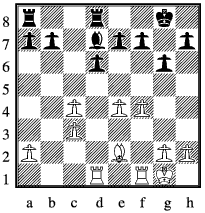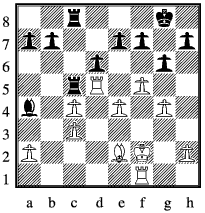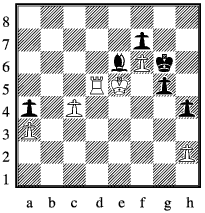
November 2017
Newcastle travelled to Holmes Chapel tonight to take on their A team in division one, with RR given the non-trivial task of facing Pat Bennett. At least RR had white.

|
| RR v Pat Bennett after 10 ... Ng4 |
With his last move Pat has unleashed a double attack on the d4 knight, which is protected twice, except that one of those protectors is now also under attack. Do I start 11 Nxc6 or 11 Bxg4?
11 Nxc6 leads to 11 ... Nxe3, 12 Nxd8 Nxd1 and a choice of how to remove the marauding knight whereas 11 Bxg4 could lead to the large scale exchange
11 ... Bxg4, 12 Qxg4 Bxd4, 13 Bxd4 Nxd4, whilst after the game Pat pointed out the option
11 Bxg4 Bxg4, 12 Nxc6 Qd7 (anything else loses a piece)
13 Nxe7+ Kh8, 14 Nxg6+ fxg6 and white emerges two pawns to the good. Had Stockfish been present he would have countered with
11 ... Bxd4, 12 Bxd4 Bxg4, 13 Qxg4 Nxd4, reaching the same position as the big swap variation.
Decisions, decisions.
RR emerged with
11 Nxc6 Nxe3, 12 Nxd8 Nxd1, 13 Raxd1 It was tempting to recapture with the knight, preserving the queenside pawn structure, and after moving the a-rook play b3 leaving blacks dark squared bishop hitting air, but unfortunately this line allows black to slip in Bd4+ and so use his bishop on what would then be the dangerous a7g2 diagonal.
13 ...Bxc3, 14 bxc3 Is it better to offer to keep pieces on with Nxb7 or Nxf7? Don't ask me, my brain's already hurting and its only move 14.
14 ... Rfxd8

|
| RR v Pat Bennett after 14 ... Rfxd8 |
15 e5 even though he doesn't want to be putting pawns on light squares. In reality this is only a minor inconvenience for black who could if he wished play f6, Be8, Bf7 to attack the c5 pawn with the bishop. However Pat had other plans.
15 ... Rac8, 16 Rd4 Rc5, 17 g4 having considered and rejected, probably incorrectly the virtues of f6.
17 ... Rdc8, 18 Rd5 Ba4, 19 Kf2

|
| RR v Pat Bennett after 19 Kf2 |
19 ... Rxc4, 20 Bxc4 Rxc4 after which RR unsportingly played
21 Rd4 stopping black from collecting the second pawn.
22 ... Bb5 with draw offer. Is this a "Have you noticed you're winning?" draw offer that Pat has borrowed form some passing junior or does he have enough structurally to make up for the small material deficit? Think I'll play on. The next several moves are understandable even when not best.
23 Rb1 b6, 24 Ke5 g5, 25 Rb4 Bf1, 26 Rd4 Kg7, 27 e5 dxe5
28 Rd7 a5, 29 Rxe7 Kf6, 30 Rb7 b5, 31 Rb6+ Kg7, 32 f6+ Kg6
33 Ke4 a4, 34 a3 Bh3, 35 Kxe5 Bxg4, 36 Rxb5 h5, 37 Rd5 A non-fatal waste of time. Passed pawns should be pushed, and as this position is not one of the numerous exceptions c4 immediately is better.
37 ... Be6, 38 c4 h4

|
| RR v Pat Bennett after 38 ... h4 |
39 c5 Kh5 RR thought he had also checked that Bxd5 her was winning for white though
39 ... Bxd5, 40 Kxd5 g4 both sides queen - white first but black on h1 with check. Draw follows. Fortunately for RR Pat seemed to believe his move.
40 c6 g4, 41 c7 g3, 42 hxg3 hxg3, 43 Kf4+ Bxd5
44 c8Q g2, 45 Qg4+ Kh6, 46 Qg5+ Kh7, 47 Qg7#
The story of the game is quite simple. RR put himself a little behind by not taking the best line through the big swap, after which each player made one serious miscalculation. RR got away with his towards the end, whereas Pat was not so lucky when he thought he'd get two pawns for the exchange. Such small differences are decisive frighteningly often.
comment on this article
So it came to pass that our 7 good men, average grade 102, sat down to pass judgement on ideas for division one, average grade of participants last year 167. Which sounds very snobby, but try reversing it - would a committee of first division players be your first port of call if there was a wish from the bottom divisions to freshen up their competitions?
Some of their comments on Simon's proposal as taken from the minutes follow, with my thoughts in italics. The minutes of course may be sufficiently accurate to convey general feelings without being precise enough to justify my responses.
Steve Emmerton: There would be a big gap between teams currently in division one and two. Identifying the problem faced in a nutshell.
David Hulme: Can't see Crewe going for it - don't have the players at the moment for division 1. David of course is famous for knowing that the solution is promotion and relegation even before he knew the problems peculiar to North Staffs that the league faces. Those who were around in the days of promotion and relegation will well remember that support for it was largely on the "some other clubs teams should be the makeweights" basis.
Robert Milner: Reliance on grades is artificial and limiting teams to a team limit is killing the league. There has undoubtedly been a continuation of the rebalancing of the league towards lower graded players which was evident even before we did away with promotion and relegation. If the majority of new people walking through club doors are well past the age where they might be seeking to become world champion this is inevitable. Most clubs don't have the links and enthusiasm to take advantage of them to grow their own crop of strong players from scratch.
He is surprised that players don't want the challenge of testing themselves against higher rated players. Says a man who has long since given up testing himself over the board against anyone except in the direst of emergencies. Seems to be alarmingly out of touch with the motivation of the majority who while not objecting to being given the odd lesson prefer their chess to involve evenly matched games.
Concerned about attracting new players to the league - we have no players graded 200. New players are not in the least bit concerned about the strength of the players competing in the league, unless its a case of being fearful that there is no-one of a sufficiently modest standard to give them a game. The league may well not be strong enough to encourage top players to commute in from outside the league's catchment area, but the idea that we are Staffordshire's answer to the London League where double digit sided teams of household names swarm into the central London venues to get their fix is somewhat fanciful. As for no players graded 200, last year saw Lawrence Cooper (210), Stuart Clarke (208) and Robert Shaw (203) on the scorecards.
Stuart Green: Not a lot of players want to play opposition graded higher than themselves looking at congress entries. It is indeed true that at congresses most players enter the lowest section for which they are eligible. And these are the players who are keen enough to give up whole weekends to pursue the game.
Roger Edwards: Martyn Harris had proposed that division one be reduced to 2 board teams of combined grade of no more than 350. See earlier.
Steve Emmerton: Objected - in effect this will make division one a doubles division. A statement of the bleeding obvious, apart from the first word, which is given no justification.
It was agreed that the league structure would be an issue for the next AGM.
Steve Emmerton: (summarising others comments) There are three options
| 210 L Cooper | 190 M Harborne | 176 M Hancock | 160 D Hulme |
| 203 R Shaw | 187 L Grinsell | 175 R Heinlein | 159 M Harris |
| 196 G Acey | 187 P Bennett | 174 A Soames | 157 G Laurence |
| 195 D Buxton | 182 S Edwards | 165 J Boswell | 157 B Jones |
| 190 A Richardson | 178 J Turner | 161 J Booth | 156 D Risley |
| 154 P Cattermole | e148 Derek Price | 141 J Blackburn | 134 S Emmerton |
| 153 I Bates | 146 A Paling | e140 M Launay | 134 K McNulty |
| 151 K Lockett | 145 A Thomason | 138 S Hill | 133 J Cartlidge |
| 150 R Wiltshir | 145 G Valentine | 137 K Grzybowski | 132 J Yee |
| 149 W Armstrong | 143 R Taylor | 136 N Layhe | 131 M Roberts |
Thus the problem is not so much that there are too few strong players in the North Staffs area but that those that do exist, particularly the strongest, are concentrated in a few clubs. Moreover two of the current big four - Holmes Chapel and Stafford - play in other leagues, so their players may not be too keen on extra matches in which the main objective is not to slip up against significantly weaker teams. Only they know.
The gap between the top two divisions is illustrated by the team totals taken from my analysis of last season's figures. Note that the second division totals are those after applying the minimum counting grade, without that they would have been a little lower.
| Division 1 | average | biggest | least |
| Cheddleton A | 855 | 921 | 761 |
| Holmes Chapel A | 850 | 946 | 819 |
| Newcastle A | 821 | 827 | 789 |
| Stafford A | 814 | 938 | 677 |
| Division 2 | |||
| Cheddleton B | 720 | 725 | 715 |
| Crewe A | 699 | 713 | 687 |
| Holmes Chapel Rooks | 669 | 703 | 620 |
| Macclesfield | 718 | 725 | 707 |
| Newcastle B | 709 | 720 | 665 |
| Newcastle C | 714 | 722 | 710 |
Time for a thought experiment. What would happen if we adopted Simon Edwards' proposal that division 2 be scrapped and that a limit of 850 be placed on any teams playing in the new division one?
Over the years Cheddleton and Newcastle division two teams have not existed as separate entities to their first division sides, rather they have existed mainly to give their first division players more games. As they have not elected to field two division one teams under the current scheme, there seems little reason to suppose they would under Simon's.
Rooks appear to exist for the benefit of a distinct set of players to Holmes Chapel A, though the latter's members do help out. Difficult to see two division one teams form them, particularly as it would be easy for Rooks to fit into division three if they wished.
That would leave Macclesfield, Crewe and Fenton. Even if they all entered the new division one they would find the majority of their matches unattractively tough. Without reinforcements thay might well consider splitting their strength to create more teams eligible for division three so as to avoid existing simply to amke the numbers up.
Thus Simon's proposal might lead to a short term increase in numbers but could equally easily in the medium term leave the current first division one clubs in sole ownership of the new division one with an even bigger gulf than now between the top and next divisions. Indeed if Macclesfield came to the conclusion that they could not get the chess they wanted in either of the new top two divisions we could even lose a club. Has anyone asked them?
We could envisage a set-up in which we abandon club affiliations and ask eight leading players to each head-up a team, with players allocated by a draft system to ensure reasonably even competition. However not only would this not meet the approval of those organisers who bask in the reflected glory of their clubs success, but there are considerable practical problems over venues, transport and substitutes. Consequently I don't see that this could be worked up into a serious proposal.
Any other solution? See next article.
comment on this article
Expecting to consistently get more teams in division one under the current set-up is unreasonable, at least for the foreseeable future. I believe that trying to force teams to play up against their wishes will be counter-productive, and that the idea of captains teams spread across several clubs is impractical unless we acquire a central venue for all matches.
Simon and I have both had no success in establishing individual competitions for the top players - dates will always be a problem.
Can we get more teams by splitting up those that already exist? To achieve this we would need to reduce the number of players per team. Does anyone seriously believe that a reduction from five to four in the numebr of players would cause the division one clubs to need two division one teams? Not I. How about teams of three. Possibly, but at least equally possibly not. What happens if we go the full hog and have teams of two?